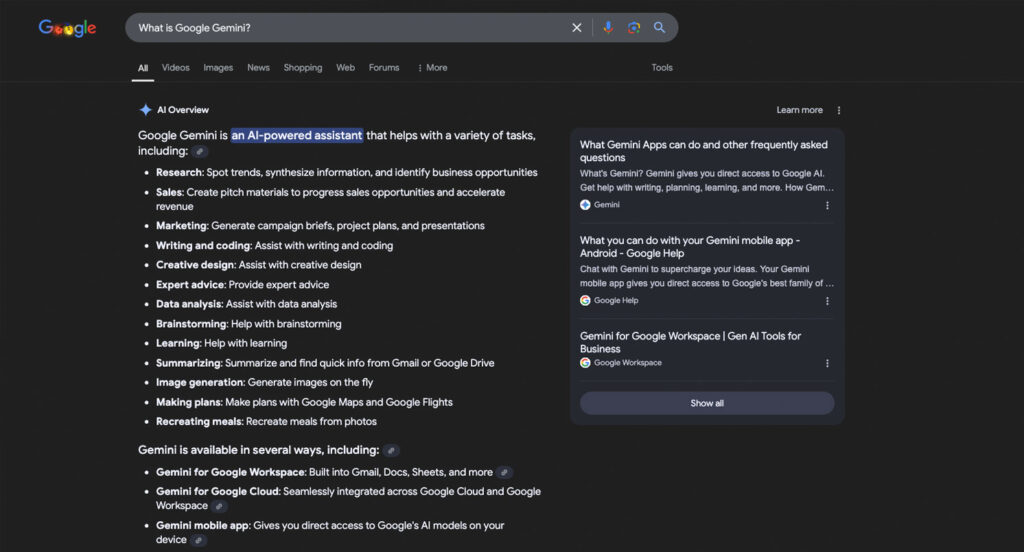Adapting to Search Generative Experience (SGE): What SEOs Need to Know
The web is undergoing a significant transformation with the integration of artificial intelligence (AI) into search engines. Google’s Search Generative Experience (SGE) exemplifies this shift, aiming to enhance user interactions by providing AI-generated summaries directly within search results.
For businesses and digital marketers, this evolution presents both opportunities and challenges. Understanding SGE and its implications is crucial for adapting SEO strategies to maintain and improve online visibility.
What Is Search Generative Experience (SGE)?
SGE is an AI-driven enhancement to traditional search methods, designed to offer users concise, contextually relevant summaries at the top of search results. By synthesizing information from various sources, SGE aims to provide immediate answers to user queries, reducing the need to navigate through multiple links.

The Growing Influence of AI in Search
The incorporation of AI into search engines is reshaping how information is accessed and presented. AI models analyze user intent more accurately, delivering personalized and efficient search experiences. This progression necessitates that businesses stay informed and agile, adjusting their digital strategies to align with the evolving search environment.
This article aims to provide a comprehensive understanding of SGE and its impact on SEO. By exploring the mechanics of SGE, identifying challenges, and offering actionable optimization strategies, we seek to equip businesses and marketers with the knowledge to navigate and thrive in this AI-enhanced search landscape.
Understanding Search Generative Experience (SGE)
The Search Generative Experience (SGE) is revolutionizing the way search engines operate, bringing artificial intelligence into the forefront of how users find and interact with information. SGE aims to streamline the search process by delivering concise, AI-generated summaries at the top of search engine results pages (SERPs). These summaries are crafted by analyzing and synthesizing content from multiple credible sources, providing users with immediate, actionable insights.
What Sets SGE Apart?
AI-Powered Summaries
SGE’s hallmark feature is its ability to generate summaries that encapsulate the essence of a topic. These summaries often eliminate the need for users to sift through multiple links, offering quick answers to complex queries. For example, searching for “SEO trends in 2024” might produce a bulleted list of key points derived from leading industry articles.
Enhanced Contextual Understanding
By leveraging advanced machine learning models, SGE goes beyond keyword matching. It interprets user intent with greater accuracy, considering nuances and context to deliver results that are relevant and insightful. For instance, a query like “how to improve local SEO for small businesses” would yield personalized suggestions tailored to local businesses’ needs.
Visual and Interactive Features
SGE incorporates multimedia elements such as images, videos, and interactive links to enrich the user experience. These visual aids not only make information more engaging but also allow users to interact with content in new and meaningful ways.
How SGE Differs from Traditional Search
Traditional Search
- Provides a ranked list of blue links with brief meta descriptions.
- Relies heavily on user interaction to navigate to external websites for detailed information.
Search Generative Experience
- Offers AI-generated summaries directly in the SERP, answering user queries without requiring additional clicks.
- Reduces dependency on external sources for straightforward questions.
Why SGE Matters for SEO
The introduction of SGE presents both challenges and opportunities for businesses. While it enhances user convenience, it can reduce organic click-through rates by prioritizing on-SERP answers. To remain competitive, businesses must adapt their SEO strategies to ensure their content is featured prominently in these summaries.

Key Features of Search Generative Experience (SGE)
Search Generative Experience (SGE) is designed to enhance the way users interact with search engines by combining artificial intelligence and advanced contextual analysis. Its unique features provide a more intuitive, efficient, and engaging search process. Here’s a closer look at the core elements that define SGE:
AI-Driven Summaries
SGE uses cutting-edge AI algorithms to deliver brief, yet comprehensive, responses to user queries. These summaries synthesize information from multiple authoritative sources and present it in a format that’s easy to digest.
- How it works: SGE scans relevant content, extracts key points, and compiles them into a concise narrative or list.
- User Benefit: Eliminates the need to browse through several links for basic information, saving time and effort.
- Example: A search for “benefits of content marketing” might return a list of bullet points summarizing advantages such as increased brand visibility, better customer engagement, and improved SEO.
Contextual Relevance
SGE excels in understanding the context of a query, moving beyond simple keyword matching to interpret the intent behind user searches.
- How it works: Advanced natural language processing (NLP) enables SGE to identify nuances in phrasing, synonyms, and related terms.
- User Benefit: Ensures search results are aligned with the user’s actual needs and expectations.
- Example: A query like “best running shoes for trail running” will provide tailored suggestions for trail-specific footwear rather than generic options.
Rich Visual Elements
SGE integrates visual aids, such as images, videos, graphs, and infographics, directly into the search results.
- How it works: By pulling multimedia content from indexed sources, SGE adds visual depth to its summaries.
- User Benefit: Enhances engagement and aids in understanding complex topics through visual representation.
- Example: Searching for “steps to bake a cake” might generate a step-by-step guide alongside images or a short instructional video.
Interactive Features
SGE includes interactive components like expandable FAQs, clickable suggestions, and dynamic search refinements to further refine and enhance the user journey.
- How it works: Offers prompts for follow-up questions or related searches based on the user’s initial input.
- User Benefit: Encourages exploration and helps users drill down into specific aspects of their query.
- Example: A search for “SEO tools” might include interactive links to reviews, pricing comparisons, and detailed tool features.
Real-Time Updates
SGE incorporates real-time information, ensuring users receive the most current and relevant data for their queries.
- How it works: It leverages live updates from trusted sources, particularly for time-sensitive topics like news, events, or market trends.
- User Benefit: Provides confidence in the accuracy and timeliness of search results.
- Example: Searching for “latest stock market trends” would generate summaries using real-time market data.
Personalized Search Results
SGE adapts its results based on user preferences, search history, and geographic location.
- How it works: AI models analyze individual user behavior to prioritize content that aligns with their needs.
- User Benefit: Delivers a more personalized and relevant search experience.
- Example: A user in Ocala searching for “web design services” might see results prioritizing local businesses, such as GraphicTen.
Why These Features Matter for SEO
Understanding and optimizing for these SGE features allows businesses to:
- Gain visibility in AI-driven summaries.
- Present content in a format conducive to multimedia and contextual relevance.
- Stay competitive in a rapidly evolving search environment.

Challenges Posed by SGE for SEO
The introduction of Search Generative Experience (SGE) presents new opportunities, but it also brings significant challenges for businesses and SEO professionals. Understanding these obstacles is crucial for adapting strategies and maintaining a competitive edge in the digital landscape.
Decreased Organic Click-Through Rates (CTR)
One of the most significant challenges is the decline in organic CTR. Since SGE provides immediate answers within the search results page, users often find the information they need without clicking on any links.
- Impact on Businesses: Websites may experience a reduction in traffic, particularly for queries that SGE can answer comprehensively.
- Solution: Create in-depth, high-value content that encourages users to click through for more detailed information. Include elements like downloadable resources, interactive tools, or extended insights not available in the summary.
Increased Competition for Featured Results
With SGE, fewer positions are available for visibility within the AI-generated summaries, heightening the competition among websites to be featured.
- Impact on Businesses: Even strong SEO efforts might not guarantee inclusion in the AI summary.
- Solution: Optimize content for relevance and authority by adhering to E-E-A-T (Experience, Expertise, Authoritativeness, Trustworthiness) principles. Use structured data and schema markup to help AI understand your content better.
Dependency on Accurate AI Representation
SGE relies on AI to interpret and summarize content, but it may misrepresent or oversimplify information, potentially leading to misunderstandings about your brand or services.
- Impact on Businesses: Misrepresentation in summaries can harm brand credibility and trust.
- Solution: Ensure content is clear, accurate, and well-structured. Regularly monitor how your content is summarized in search results and adjust if necessary.
Reduced Visibility for Niche Queries
As SGE prioritizes broader, high-traffic queries, niche or highly specific searches may not yield AI summaries, limiting visibility for specialized businesses.
- Impact on Businesses: Difficulty reaching a targeted audience through niche search terms.
- Solution: Continue targeting long-tail keywords and create content that fills gaps left by SGE, addressing highly specific user needs.
Adaptation Costs
The shift to SGE requires businesses to reassess and update their SEO strategies, which can be resource-intensive.
- Impact on Businesses: Smaller businesses with limited resources may struggle to adapt quickly.
- Solution: Focus on scalable SEO tactics, such as optimizing existing content and leveraging free or affordable tools for data analysis and content improvement.
Fragmented User Journey
While SGE enhances search convenience, it can also fragment the user journey by reducing the time spent on individual websites.
- Impact on Businesses: Fewer opportunities to engage users directly and guide them through the sales funnel.
- Solution: Develop engaging calls to action (CTAs) and ensure your website offers an exceptional user experience to capture attention once users click through.
Embracing the Challenges
While the challenges of SGE may seem daunting, they also present opportunities to innovate and refine SEO strategies. By focusing on content quality, technical optimization, and user engagement, businesses can remain relevant and competitive in the evolving search ecosystem.

Strategies for Optimizing for Search Generative Experience (SGE)
Adapting to the evolving landscape of Search Generative Experience (SGE) requires a proactive and strategic approach. By focusing on creating high-quality content, enhancing technical SEO, and aligning with SGE’s unique features, businesses can maximize their visibility and stay competitive.
Create Comprehensive and Relevant Content
SGE prioritizes content that comprehensively addresses user queries. Your content needs to be detailed, authoritative, and user-focused.
- Focus on E-E-A-T: Ensure your content demonstrates Experience, Expertise, Authoritativeness, and Trustworthiness to rank higher in AI summaries.
- Address User Intent: Anticipate user questions and provide direct, actionable answers within your content.
- Example Strategy: If targeting “local SEO for small businesses,” include step-by-step guides, case studies, and tools that small business owners can immediately use.
Optimize for AI-Driven Summaries
Content must be structured in a way that AI can easily extract and summarize.
- Use Structured Data: Implement schema markup (FAQ, How-To, Product) to help search engines understand your content.
- Include Scannable Content: Use headings, bullet points, and concise paragraphs to make your content easier for AI to process.
- Example Strategy: For a blog on “top SEO tools,” create a bulleted list summarizing each tool’s features and benefits.
Embrace Multimedia Optimization
SGE often includes rich media elements like images, videos, and infographics.
- Optimize Images: Use descriptive file names, alt text, and compress images for faster load times.
- Leverage Video Content: Create short, informative videos that directly address common queries in your niche.
- Example Strategy: Include an explainer video in your content about “how to perform an SEO audit.”
Build Topical Authority
Search engines favor websites with strong authority in specific subject areas.
- Cluster Your Content: Develop content clusters around core topics, linking them together to demonstrate expertise.
- Example Strategy: If your focus is “local SEO,” create interlinked articles on topics like citation building, Google My Business optimization, and local link building.
Enhance User Experience (UX)
User experience directly impacts rankings in SGE.
- Improve Page Speed: Use tools like Google PageSpeed Insights to optimize loading times.
- Mobile Optimization: Ensure your website is fully responsive and easy to navigate on mobile devices.
- Example Strategy: Simplify navigation by using clear CTAs and an intuitive menu structure to retain visitors.
Monitor and Measure Performance
Tracking your visibility in AI-generated summaries is key to refining your strategy.
- Use SEO Tools: Leverage tools like Google Search Console to track impressions and clicks.
- Analyze SGE Behavior: Pay attention to which queries trigger your content in AI summaries and refine based on performance.
- Example Strategy: Identify queries where your content doesn’t appear and adjust by adding new insights or reformatting existing articles.
Adapt to Evolving Trends
SGE is an evolving feature, and staying informed is crucial.
- Stay Updated: Regularly follow Google’s updates and algorithm changes.
- Experiment and Innovate: Test different content formats and analyze what works best for inclusion in SGE.
Why These Strategies Matter
By implementing these strategies, businesses can ensure their content is visible and relevant in an SGE-driven search environment. Optimized content not only increases the chances of being featured in AI summaries but also enhances overall SEO performance.

Measuring Success in the SGE Era
As Search Generative Experience (SGE) reshapes the digital landscape, measuring the effectiveness of your SEO strategies becomes essential. The metrics and tools traditionally used to assess performance must now adapt to the nuances of AI-driven search. Here’s how to evaluate your success in the SGE era.
Track Visibility in AI Summaries
One of the key goals of SGE optimization is to have your content featured in AI-generated summaries.
- Monitor Impressions: Use Google Search Console to track impressions for specific queries that align with your target keywords.
- Evaluate Positioning: Analyze whether your pages are appearing as a source for AI summaries and whether they rank prominently for related keywords.
- Example Metric: “Number of times content is cited in AI-generated summaries.”
Assess Organic Click-Through Rates (CTR)
While SGE provides answers directly on the SERP, ensuring users still click through to your website is critical.
- Monitor CTR Changes: Use analytics tools to track shifts in CTR, especially for high-traffic queries.
- Optimize Meta Content: Enhance meta descriptions and titles to entice users to click for more detailed information.
- Example Metric: “CTR for queries with AI-generated summaries.”
Measure User Engagement
Once users land on your website, their behavior can indicate the effectiveness of your content.
- Analyze Dwell Time: Longer time spent on your site suggests that users are finding value in your content.
- Track Bounce Rates: A high bounce rate may indicate that the content doesn’t meet user expectations or needs improvement.
- Example Metric: “Average time spent on pages optimized for SGE.”
Monitor Traffic Sources
SGE might change the composition of your traffic sources, making it important to analyze where your visitors are coming from.
- Segment SGE Traffic: Compare traffic patterns before and after implementing SGE-focused strategies.
- Identify New Opportunities: Look for emerging keywords or queries where SGE drives impressions.
- Example Metric: “Percentage of traffic attributed to queries generating AI summaries.”
Evaluate Content Performance
Content optimization plays a significant role in SGE success. Regularly assess which pages perform well and which need improvement.
- Use Heatmaps: Tools like Hotjar can reveal how users interact with your content, helping to identify high-engagement areas.
- Track Conversions: Measure how well your content drives users to take desired actions, such as signing up for a newsletter or making a purchase.
- Example Metric: “Conversion rate of pages optimized for SGE queries.”
Analyze Backlink Quality
SGE relies on authoritative sources for its summaries. Building a strong backlink profile increases your chances of being featured.
- Monitor Referring Domains: Track the number and quality of websites linking to your content.
- Encourage Organic Links: Publish high-value content that naturally attracts backlinks.
- Example Metric: “Growth in backlinks to SGE-optimized pages.”
Leverage Real-Time Feedback
Real-time monitoring helps you stay agile and adjust your strategy as needed.
- Use SEO Tools: Platforms like SEMrush, Ahrefs, or Moz can provide real-time insights into keyword rankings and performance.
- Example Metric: “Keyword position changes for SGE-focused queries.”
Why These Metrics Matter
Measuring the right metrics allows you to:
- Identify what’s working and refine underperforming strategies.
- Justify ROI for SEO efforts in an SGE-driven landscape.
- Stay ahead of competitors by continuously improving your approach.
Actionable Next Steps
- Set up a dashboard to track SGE-specific metrics in tools like Google Analytics and Search Console.
- Regularly review performance data and adjust your optimization strategies accordingly.
- Keep experimenting with content formats and techniques to align with evolving search trends.
Future Trends and Predictions for Search Generative Experience (SGE)
The evolution of Search Generative Experience (SGE) signifies a profound shift in how users interact with search engines, and this transformation is far from over. As AI technologies continue to advance, SGE is poised to become even more powerful and integrated into daily online activities. Here’s a look at the future trends and what they mean for businesses and SEO professionals.
Deeper Integration of AI Models
As AI models become more sophisticated, SGE will likely enhance its ability to interpret user intent and deliver hyper-personalized results.
- Prediction: SGE will utilize advanced natural language models, like OpenAI’s GPT or Google’s Gemini, to create nuanced and contextually rich summaries.
- Impact: Businesses will need to focus on creating content that is not only relevant but also aligns closely with specific user needs and contexts.
Expansion of Multimedia Results
The future of SGE is likely to include even more dynamic and engaging multimedia elements.
- Prediction: Videos, augmented reality (AR) content, and interactive infographics will play a larger role in SGE results.
- Impact: Businesses will need to invest in creating high-quality multimedia content optimized for search engines.
Increased Focus on Localized Results
SGE will continue to refine its localization capabilities, making results more relevant to the user’s geographic location.
- Prediction: AI-generated summaries will include hyper-local data, such as nearby events, local business recommendations, and real-time updates.
- Impact: Local SEO will become even more critical, with businesses needing to optimize for geographic-specific keywords and queries.
Enhanced User Interaction
Interactive elements, such as question prompts and conversational search, will become a hallmark of SGE.
- Prediction: Users will be able to ask follow-up questions or refine their searches within the SGE framework, creating a more conversational search experience.
- Impact: Content strategies will need to anticipate follow-up questions and provide layered answers to keep users engaged.
Real-Time Data Integration
SGE will increasingly incorporate real-time information to deliver the most up-to-date answers.
- Prediction: Integration with live data feeds, such as stock prices, weather updates, and breaking news, will become standard.
- Impact: Businesses in fast-moving industries will need to ensure their content is updated regularly to remain relevant.
Greater Emphasis on Authoritativeness
As misinformation becomes a growing concern, SGE will prioritize content from authoritative and trustworthy sources.
- Prediction: Google and other search engines will give greater weight to verified authors, expert contributions, and transparent sourcing.
- Impact: Businesses should build credibility by showcasing expertise and using verified credentials in their content.
Expansion of Zero-Click Searches
With SGE providing more answers directly in the SERP, zero-click searches will become increasingly prevalent.
- Prediction: Users will rely more on AI-generated summaries, reducing the need to visit external websites for basic information.
- Impact: Businesses must focus on content strategies that encourage deeper engagement, such as interactive tools, calculators, or downloadable resources.
Growth of Predictive Search
AI in SGE will likely evolve to anticipate user needs before a query is even made, based on historical data and behavior patterns.
- Prediction: Predictive search features will suggest information proactively, similar to recommendation engines.
- Impact: Businesses can benefit by aligning their content with user trends and anticipated needs.
Preparing for the Future
To stay ahead, businesses and marketers should:
- Continuously monitor advancements in AI and SGE technologies.
- Prioritize creating high-quality, user-focused content that aligns with E-E-A-T principles.
- Invest in multimedia and local SEO strategies.
- Embrace agility, regularly updating and experimenting with their SEO tactics.
Conclusion
The future of SGE promises exciting possibilities, but it also demands adaptability. Businesses that anticipate these trends and evolve their SEO strategies will be well-positioned to thrive in an AI-driven digital landscape. By staying informed and proactive, you can ensure your content remains visible, engaging, and impactful.


